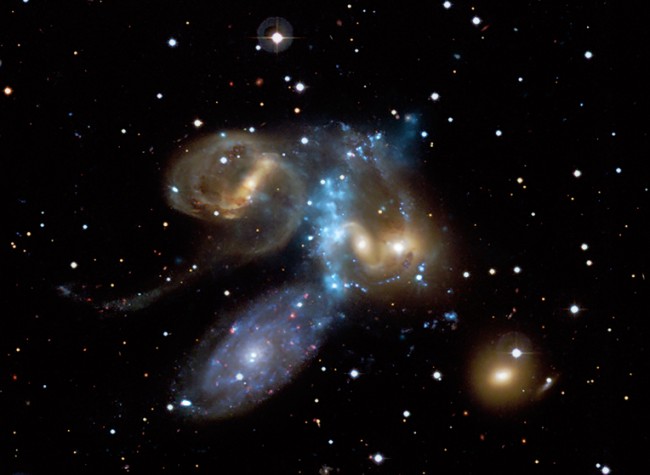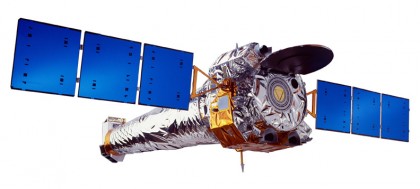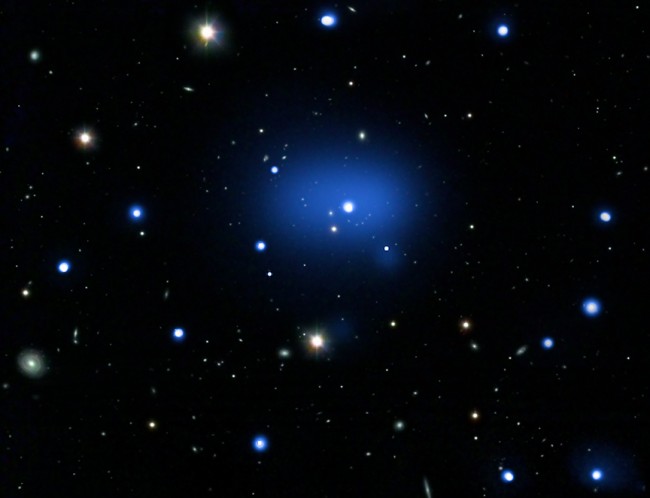23 October 2009
Ancient Light Into The Shiny Bucket
Posted by Dan Satterfield

A cluster of Galaxies seen by the Chandra X-Ray Telescope. Click the image for info on what is happening here. Then come back to find out about the most distant cluster known.
Astronomers call telescopes light buckets. This is because they are really just buckets that catch photons of light. Your backyard telescope catches photons that have mostly been travelling through space for a short time. Photons from the moon have only been travelling for 1.5 seconds. The photons from the Sun about 8 minutes.
Mars is about 15 light minutes away and Pluto is just under 6 light hours away. So if you could travel travel at light speed, you would go around the Earth 8 times in one second, and you can get to Pluto (No, it’s NOT a planet!- don’t get me started ) in 13 hours!
If you look through binoculars to see the Andromeda Galaxy, then you are catching photons that have been travelling for two and a half million years. In cosmic terms, that is a next door neighbour! The Hubble and Chandra telescopes can make images out of photons that have been travelling for BILLIONS of years. If an objects is so far away that it’s light takes 100 years to get here, then it’s 100 light years away. If you think of it that way, the huge distances in the universe make a little more sense. Our puny distance measures like miles and kilometers mean nothing.
You might ask, what is the most distant galaxy we can see??
The folks who run the Chandra X-ray telescope asked that very question, and they announced Thursday they had a new most distant galaxy. It’s actually a cluster of galaxies. Believe it or not, even huge galaxies like the Milky Way attract each other, and form groups. Astronomers believe that these clusters first formed when the universe was only about 3 Billion years old. It about 13.7 Billion years old now.
So look at the picture below. The blue haze is a cluster of galaxies 10.3 Billion light years away. You are looking at the cluster before the Milky Way likely even existed, much less Earth! The Astronomers had to give it a mysterious scientific name of course and they came up with jcks041. Not to be confused with jkcs042 which we all of course know intimately!
NOT.
You might think the photons were happy to stop travelling and reach someplace, but at light speed time itself stops. They didn’t age at all on the trip!
We get this kind of incredible view for the cost of a couple of jet fighters. Imagine if we spent some real money on Science…
Later,
Dan




 Dan Satterfield has worked as an on air meteorologist for 32 years in Oklahoma, Florida and Alabama. Forecasting weather is Dan's job, but all of Earth Science is his passion. This journal is where Dan writes about things he has too little time for on air. Dan blogs about peer-reviewed Earth science for Junior High level audiences and up.
Dan Satterfield has worked as an on air meteorologist for 32 years in Oklahoma, Florida and Alabama. Forecasting weather is Dan's job, but all of Earth Science is his passion. This journal is where Dan writes about things he has too little time for on air. Dan blogs about peer-reviewed Earth science for Junior High level audiences and up.
Yes, Pluto IS a planet. Only four percent of the IAU voted on the controversial demotion, and most are not planetary scientists. Their decision was immediately opposed in a formal petition by hundreds of professional astronomers led by Dr. Alan Stern, Principal Investigator of NASA’s New Horizons mission to Pluto. One reason the IAU definition makes no sense is it says dwarf planets are not planets at all! That is like saying a grizzly bear is not a bear, and it is inconsistent with the use of the term “dwarf” in astronomy, where dwarf stars are still stars, and dwarf galaxies are still galaxies. Also, the IAU definition classifies objects solely by where they are while ignoring what they are. If Earth were in Pluto’s orbit, according to the IAU definition, it would not be a planet either. A definition that takes the same object and makes it a planet in one location and not a planet in another is essentially useless. Pluto is a planet because it is spherical, meaning it is large enough to be pulled into a round shape by its own gravity–a state known as hydrostatic equilibrium and characteristic of planets, not of shapeless asteroids held together by chemical bonds. These reasons are why many astronomers, lay people, and educators are either ignoring the demotion entirely or working to get it overturned.
I love this battle over Pluto. It truly is the workings of science for all to see. Good points Laurel. You almost convinced me. Almost…. 😉
Tag, you’re “it”
http://greenfyre.wordpress.com/2009/10/23/the-woody-guthrie-award-for-thinking-blogger/
I really like when people are expressing their opinion and thought. So I like the way you are writing